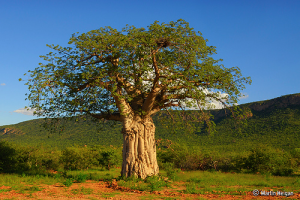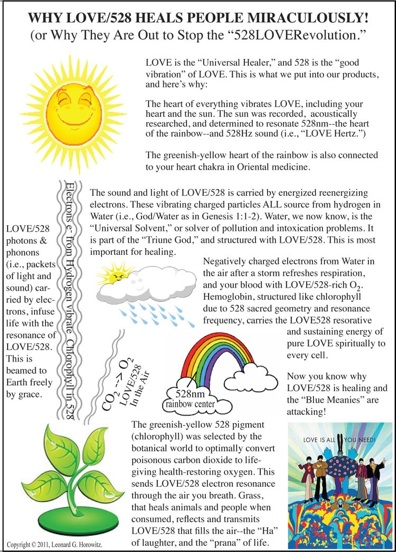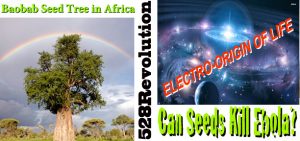Is the Cure for Ebola in Bitter Seeds?
Can Alkalizing Seeds Commonly Found in Africa Be the Hidden Cure for Ebola?
by
Dr. Leonard G. Horowitz
Abstract
Can bitter seeds from Adansonia digitata – the African baobab tree – be a secret cure for Ebola? This article advances this probability, along with revolutionary knowledge of the factors necessary for establishing vital immunity and spontaneous healing involving the availability of electrons, and their preferred resonance frequencies. This intelligence is applied in natural medicine and involves known bio-energetic, electro-chemical, and bio-physical reactions impacting cells, tissues and whole organisms, that may be facilitated by, among other things, raw seed consumption.
Eating raw seeds for human health, greater longevity, and disease prevention, is not new, but this fundamental understanding of sustaining natural energy featuring the 528nm/Hz frequency of electro-resonance is new, as is the importance of alkalizing electrons that generate chemo-electric potentials for growth, development, sustenance, and rejuvenation. All these reactions may be supplemented by consuming the highly concentrated alkalizing electrons contained in the baobab seed’s hydrated matrix of genetic material.
This author argues that these seeds, primordial life forms, hold a secret offering civilization its greatest hope for conquering most chronic and infectious diseases, including Ebola and HIV/AIDS. This thesis is based on the fact that most ailments are caused by acidifying conditions and breaches of electro-energy, commonly fueled by compromised electron availability caused by repeated assaults from lifestyle risks.
These recurring bouts of electro-energy deprivation, most commonly occurring during episodes of dehydration, hypoxia, body chemistry acidification and de-mineralization, results in lowered immunity and greater susceptibility to myriad diseases. Alternatively, the provision of these sustaining and healing factors results most reliably in prompt recoveries .
Introduction
People have received a broad spectrum of advice about nutritional risks versus benefits of eating certain raw seeds. Health information regarding fruits and nuts fills thousands of pages of scientific publications and Internet discussions, with far less discourse examining seeds and their ingredients as primordial life forms. What electro-chemical and biophysical reactions occur in the human body following consumption and digestion of raw seeds is a grossly neglected topic.
 This inquiry expands in urgency in underdeveloped countries wherein infectious diseases are threatening susceptible populations, causing economic crises, and creating public health emergencies, risking “national security” and millions of lives. Such is the case in America and Africa confronted by Ebola. Here, human immunity and the provision of remedies is challenged by ignorance and economic hardship. Lacking knowhow in these neglected fields, coupled with general dehydration in pure water deficient populations, including in America wherein municipal water purification systems rely on acidifying additives, is insidiously deadly.
This inquiry expands in urgency in underdeveloped countries wherein infectious diseases are threatening susceptible populations, causing economic crises, and creating public health emergencies, risking “national security” and millions of lives. Such is the case in America and Africa confronted by Ebola. Here, human immunity and the provision of remedies is challenged by ignorance and economic hardship. Lacking knowhow in these neglected fields, coupled with general dehydration in pure water deficient populations, including in America wherein municipal water purification systems rely on acidifying additives, is insidiously deadly.
According to U.S. Environmental Protection Agency, in their CADDIS Report on pH within the government’s “Sources, Stressors, and Responses” monograph (1), “High pH levels occur when hydroxide ion concentrations are high and hydrogen ions are scarce. Although acidic conditions more commonly result from human activities, . . .” The report goes on to state, “[t]here also are natural sources which can result in high pH conditions, such as naturally alkaline geologies and lithologies and high levels of photosynthesis. [Emphasis added.] Because photosynthesis produces hydroxide ions, elevated nutrient concentrations may contribute to pH increases. .”
These are similar to the conditions that one generates in the human body, and in health chemistry, when bitter-tasting highly-alkaline seeds are eaten. These alkalizing electrons source fundamentally from photosynthesis because the electrons bonded to elemental oxygen in the hydroxyl ion source originally from the sun and solar radiation.
Background
Magaia et. al., studied the availability of vital nutrients in whole seeds, including iron for red blood cell production, magnesium for proper nerve function, and zinc, vital to the physiology of respiration and cellular oxygenation severely challenged during periods of dehydration common in African nations. (2)
This group compiled extensive data on vital elements that evidence the subject of this article—energy transfers in the administration of life.
 Magaia et. al. (2), collected data on the baobab tree–the most widespread of the Adansonia species in Africa. The tree is found in the hot, dry savannahs of sub-Saharan region. The tree’s English names include the “monkey-bread tree” since the soft, dry fruit is edible, and “upside-down tree” because the sparse branches often resemble roots.
Magaia et. al. (2), collected data on the baobab tree–the most widespread of the Adansonia species in Africa. The tree is found in the hot, dry savannahs of sub-Saharan region. The tree’s English names include the “monkey-bread tree” since the soft, dry fruit is edible, and “upside-down tree” because the sparse branches often resemble roots.
Adansonia digitata seed science substantiates this article’s main thesis–that the fundamental ingredients in all bitter tasting seeds are energized electrons. These fuel the explosive growth, medicinal potential, and nutritional value associated with vitamins, minerals, essential fatty acids proteins/enzymes, and energy releasing carbohydrates. Each of these factors are associated with the known disappearance of a wide range of diseases. (Ob cit., Magaia et. al.,[2])
The baobab is a traditional food plant in Africa, but little is known about this plant elsewhere. Even in Africa, however, people remain clueless as to how baobab seeds actually work in the body to produce nutritional sustenance and healing. The baobab fruit has been suggested to have the potential to improve nutrition, but the tree’s use to boost food security, foster rural development, and support sustainable land care has been limited.
The African baobab’s fruit contains 50% more calcium than spinach, is high in antioxidants, and has three times the vitamin C of an orange. According to Wikipedia, this is superfruit. The dry pulp can be eaten fresh or dissolved in water or milk, “to make a refreshing drink.” The seeds are pounded to extract cooking oil.
Farmers cut the thick seed coats to speed up germination from many months or even years, to one week.
Clearly, based on this observed dramatic acceleration of growth, the seed is literally bursting with energy. Cutting the coat simply frees this explosive energy to provide life-sustaining remedies for malnutrition and infectious diseases as explained below.
The Energizing Ingredient in Seeds
 The explosive growth and therapeutic value in the baobab seed is fundamentally fueled by resonating electrons that vibrate most powerfully in the central light and sound range of the sun–528nm frequency light energy photons, and 528Hz frequency acoustic energy phonons.
The explosive growth and therapeutic value in the baobab seed is fundamentally fueled by resonating electrons that vibrate most powerfully in the central light and sound range of the sun–528nm frequency light energy photons, and 528Hz frequency acoustic energy phonons.
The 528nm of light energy resonance reflected by green plants has obviously been naturally selected. This is empirically obvious since this frequency reflects the pigment chlorophyll, and its central mineral magnesium. These are obviously most sustaining, genetically animating, and even curative values inherent in all green plants, reflecting the heart of the rainbow.
The “sound of the sun” has been recorded in recent years by NASA scientists. Pilot studies conducted by this author compared that sound to the 528Hz pure tone. Substantial similarities were noted as the sound of the sun seemed to waffle above and below a median of 528Hz. Additional pilot audio studies found that bee hives buzz precisely at 528Hz frequency.
Solar electrons, donated by the sun’s hydrogen, attach electro-magnetically and electro-chemically to oxygen in hydroxyl radicals in the atmosphere and in water. These electrons deliver their impacts bio-acoustically, as well as electro-chemically, due to this 528 resonance frequency acquired during the electron’s inception. It is reasonable, therefore, to theorize that seed’s similarly contain 528nm/Hz frequency resonating electrons, because they are: 1) hydrated, and 2) emerge from photosynthetic electro-genesis from which natural electo-resonance is assimilated throughout the organism by a process known in physics (and biophysics) as “phase locking” among resonating structures.
Serious investigators consider advancing multi-disciplinary science in such fields as biophysics and nuclear-magnetic resonance imaging (NMR), its theory and practice, and cymatic science that considers the impact of sound frequencies on matter, physiology, stress levels, as corroborating evidence of this primordial process sustaining life, involving oxygen’s capacity to carry 528nm/528Hz frequency resonating electrons. More empirical evidence backing this thesis comes from observations that sick animals instinctively eat green grass, green leaves, and therefore 528-resonating electro-energy also concentrated in the botanical world’s fruit and seeds, to recover, unlike domesticated primates conditioned to rely on pharmaceuticals.
More corroborating evidence for this thesis comes from the world of honey bees that gather pollen, and in the process fertilize flowers to bear fruit and seeds. Three audio recordings made from three different bee hives located in Hawaii each evidenced the frequency at which the hives buzzed as precisely 528Hz. That frequency is also fundamental to the hexagonal shape of honeycombs, best explained by evidence from the world of cymatic science reflecting the impact of acoustic frequencies on the formation of resulting (or proximal) physical structures, in this case the sacred geometric hexagonal shape repeated in honey combs.
 This knowledge of wildlife routinely eating seeds and greenery for sustenance and healing, and increasing knowledge of nature’s most natural “good vibration”– 528Hz/nm–encourages consideration of “medicinal music” now being advanced in the world of “music therapy” and even “physical therapy” wherein exercise and movement is professionally directed. These considerations and practical applications of this advancing knowledge extends beyond the respected multi-disciplinary field of psycho-neuro-immunology. (3)
This knowledge of wildlife routinely eating seeds and greenery for sustenance and healing, and increasing knowledge of nature’s most natural “good vibration”– 528Hz/nm–encourages consideration of “medicinal music” now being advanced in the world of “music therapy” and even “physical therapy” wherein exercise and movement is professionally directed. These considerations and practical applications of this advancing knowledge extends beyond the respected multi-disciplinary field of psycho-neuro-immunology. (3)
Returning to Magaia et. al.’s publication, “The whole seeds of A. digitata had extremely high iron content, 29 mg/100 g, while data in the literature range from 1.83 to 6.36 mg /100 g (Lockett et al. 2000; Osman 2004; Glew et al. 1997; Nkafamiya et al. 2007). Iron is necessary for the transport of oxygen in the blood to the cells and for supplying the body with energy, for immune function and nerve health and in addition, it is a cofactor in numerous biochemical reactions (Insel et al. 2011).
The nearly identical structuring between the iron-dependant human oxygen carrier, hemoglobin, and nature’s oxygen producer, chlorophyll, is remarkable. Iron versus magnesium nearly exclusively distinguishes red blood from the green plant pigment, with both hemoglobin and chlorophyll being curiously structured hexagonally according to their known molecular chemistry.
All sacred geometry, it is widely known especially in the fields of geometry and architecture, sources from the 360-degree circle. The pure tone of 528Hz frequency uniquely produces a 36-pointed circular star cymaglyph, published by internationally esteemed cymatics investigator, John Stuart Reed. Reed’s evidence supports the thesis that energy resonance determines physical structuring, including the hexagonally-shaped organic chemistry ring fundamental to life, reflected in every snowflake, likewise structuring the nearly identical molecules of chlorophyll and hemoglobin.
The kernels of A. digitata had the highest magnesium content in botany, around 600 – 700 mg/100 g. “This is higher than the magnesium content in other kernels or seeds,” wrote Magaia et. al. “Magnesium is of great importance for cardiac and nerve function, is involved in more than 300 biochemical reactions in the body and is involved in energy metabolism and protein synthesis.” (Insel et al. 2011).
Another important seed ingredient is zinc. Humans need zinc for growth and development, vitally important during pregnancy, infancy, and childhood (Brown et al. 1999; Insel et al. 2011). “The zinc content in the kernels of A. digitata . . . was around 5 mg/100 g, which is” quite adequate for a healthy diet. “Zinc increases the affinity of hemoglobin for oxygen, participates in taste perception and interacts with a number of hormones. In addition,
Magaia et. al. (2) concluded that consuming 60 g of A. digitata seeds can supply around 30% of iron, almost 50% of zinc, and more than 100% of magnesium, pursuant to recommended daily allowances for children.
Conflicting Claims and Public Distrust
The advent of the Internet and widespread “blogging” has made intelligence gathering for lay people a high risk activity. Disinformation agents, purporting to be “experts” in every field, abound online; and search engine selection of articles has nothing to do with quality content.
One classic example of erroneous counsel, frightening people from eating nuts and seeds sources from “Todd Dosenberry” (probably not his real name), who is a self-described “Minimalist. Travel hacker. Writer. Creator. Community builder. Smoothie artist. [and] . . . Suitcase entrepreneur.
“You are not a squirrel,” Dosenberry blogged. “You are a human being. You knew that, right? Our bodies are simply not designed to eat a lot of nuts and seeds.”
Most disconcerting about Dosenberry’s publication is the high probability that commercial interests funded the “suitcase entrepreneur” to discourage people from eating more naturally and sustainably. Surely there are “crazy people” publishing hogwash on the Internet, but what would compel any reasonable person to disparage seed consumption, other than a financial payoff? (4) (5)
Unfortunately, as evidenced by Edward Snowden’s leaked intelligence, the National Security Agency operates a counter-intelligence “cell” consisting of Internet “trolls” trained in persuasion through media communications designed to confuse people for commercial gain by multi-national corporations profiting from humanity’s needless suffering.
Similarly, it is grossly hypocritical that the “Centers for Disease Control and Prevention” claims to be dedicated to developing cures for preventable diseases, yet grossly neglects developing effective public education and prevention programs.
 According to government published data, the “CDC” spends less than four-percent (4%) of its annual budget on prevention, best explaining the abbreviated acronym “CDC,” that drops the “and P” i.d., reflecting its abysmal record on prevention and public education services, effectively their gross neglect of “Prevention” in the administration of government supported monopolistic medicine. The entire allopathic system reflects an illegal anti-trust enterprise, called “modern medicine,” that commercializes in “disease control” not prevention, or common sense education.
According to government published data, the “CDC” spends less than four-percent (4%) of its annual budget on prevention, best explaining the abbreviated acronym “CDC,” that drops the “and P” i.d., reflecting its abysmal record on prevention and public education services, effectively their gross neglect of “Prevention” in the administration of government supported monopolistic medicine. The entire allopathic system reflects an illegal anti-trust enterprise, called “modern medicine,” that commercializes in “disease control” not prevention, or common sense education.
As a result of this lacking attention to prevention and public education about basic behaviors for health maintenance, the public, and even professional world, is left up to its own follies. Regarding this matter of seeds, this system-wide deficiency is best reflected in chemistry expert, Anne Marie Helmenstine’s, published blog titled, “Laetrile, Amygdalin, and Vitamin B17” that received a firestorm of criticism from people defending whole seed consumption in replies to Helmenstine expressing reasonable concerns about excessive intake of any cyanide-containing product, pharmaceutical or natural. The public outcry clearly reflected widespread distrust of pharmaceutical special interests influencing medicine and the media, clearly justified by: a) the frequent recalls of toxic drugs previously approved for human consumption by the Food and Drug Administration (FDA) and b) family members and friends who died from drug side effects, or from following doctors’ “expert” advice; c) the media’s disproportionate prejudice against low risk, low cost, highly effective natural cures to many diseases relied upon for centuries prior to the advent of “modern medicine; d) the deprivation of human rights and health professional practices officiated under the auspices of protecting “public health and safety,” that has been increasingly damaging to the credibility of drug companies and organized medicine; and e) the substantial contributions that alternative care providers have made “against all odds” while reporting their trials and victories against diseases that, in many cases such as cancer, the pharmaceutical world has failed to conquer.
This widespread consumer distrust of institutionalized medicine, caused by the aforementioned factors, especially the repeated public deceptions later determined to cause catastrophic side effects and even new illnesses, including HIV/AIDS and other deadly infections determined by even censored scientific consensus that laboratory animal experiments and reliance on contaminated animals to produce tainted vaccinations, has reached a boiling point in many areas of Africa struck hardest by Ebola Zaire.
Another factor fueling fright is the neglect of common sense in frivolous and fraudulent diversions and misrepresentations as to the origins of these outbreaks and pandemics. For example, it is an insult to intelligence that officials claim the “natural reservoir” for Ebola is either “fruit bats” or “unknown” fueling suspicions that the 2014 Ebola outbreak in Guinea and Liberia of the 1976 Zaire strain emerged thirty-eight 38 years, and more than a thousand miles removed from where it original “emerged.” Common sense, coupled with common knowledge that these viruses mutate rapidly in the wild, implies “refrigeration” in a bioweapons or pharmaceutical laboratory played a role.
 An added cause of public distrust sources from the “natural reservoir” of HIV/AIDS and Ebola shifting from infected African chimpanzees and monkeys during the 1960s through the 1980s, to “fruit bats” in 2014, at the same time the scientific consensus and public knowledge has increased regarding the probable source of the initial outbreaks being chimpanzees used for viral vaccine and bioweapons experiments during the same exact period when these new and distinct viruses mysteriously emerged—that is, 1976 for Ebola Zaire and the first clinical case of AIDS diagnosed in New York City.
An added cause of public distrust sources from the “natural reservoir” of HIV/AIDS and Ebola shifting from infected African chimpanzees and monkeys during the 1960s through the 1980s, to “fruit bats” in 2014, at the same time the scientific consensus and public knowledge has increased regarding the probable source of the initial outbreaks being chimpanzees used for viral vaccine and bioweapons experiments during the same exact period when these new and distinct viruses mysteriously emerged—that is, 1976 for Ebola Zaire and the first clinical case of AIDS diagnosed in New York City.
Consequently, people not only have good cause to distrust mainstream pundits of AIDS and Ebola propaganda that diverts from urgently needed source intelligence required for considering these plaques as being genocidally imposed for commercial or political gain, but many people also resent the suppression of readily available natural cures, including alkalizing and chemotherapeutic agents abundantly available in seeds. All of these perceived impositions, real or imagined, generates contempt for organized medicine, and brings the entire field of “public health” and vaccinology into disrepute.
Natural Medicine in Therapeutic Seeds
What makes seeds bitter tasting is the precise reason they are reliably therapeutic. The bitterness characterizes the abundance of alkalizing electrons within the seed—a grossly-neglected fact.
In this regard, bitter seeds can be thought of as pure electro-energy packets containing the highest concentration of energizing and alkalizing electrons within a hydrated matrix of genetic material programmed for intercellular communication, growth, and development, relative to an electromagnetically directed “blueprint.” The encoded program requires an explosive event to release its potential to generate the energized electro-magnetized structure that operates according to the rules of biophysics and electro-mechanics.
Seeds, and the electrons contained therein, acquire their energy and alkalinity from simple sunshine. The sun is composed of 100% hydrogen.
 It is well known that only the greenish-yellow chlorophyll pigment in plants forms oxygen from carbon dioxide. What is not widely known is that this greenish-yellow light (measured in nanometers (nm) of “photons”) excites magnesium in chlorophyll, and oxygen* in water, to carry special 528nm photons of light-energized electrons vibrating at the heart of rainbows and sunshine. This energy boosts immunity in plants and animals most powerfully and naturally for better health, longevity, and sustainability.
It is well known that only the greenish-yellow chlorophyll pigment in plants forms oxygen from carbon dioxide. What is not widely known is that this greenish-yellow light (measured in nanometers (nm) of “photons”) excites magnesium in chlorophyll, and oxygen* in water, to carry special 528nm photons of light-energized electrons vibrating at the heart of rainbows and sunshine. This energy boosts immunity in plants and animals most powerfully and naturally for better health, longevity, and sustainability.
In general, the health of biology rests in adequate amounts of dissolved oxygen, optimal pH, low heavy metals, and environmental temperatures suitable for growth.
In nature, chlorophyll acts to produce the first two sustainability factors. It reflects, transmits, and converts electrons from solar radiation into subatomic “528 resonators.” I call this electron resonance, or frequency of electron-vibrating-energy carried obviously by oxygen, “The ‘Universal Healer’.” And referencing it so that consumers can more readily understand its power and function, I acknowledge “LOVE, the Universal Healer,” in referring to this “good vibration” as “LOVE/528” frequency–the primordial sustaining and healing force of nature and universal “musical mathematical” design fundamental to physics and biophysics.
I developed the chart below to help explain this common sense knowledge to lay persons.
Wildlife requires oxygen for growth, development, and healthy metabolism. Once dissolved oxygen is used-up or depleted, life is limited. (CLICK HERE to learn more on this topic.)
A major natural resource for environmental sustainability is the churning of water electromagnetically, adding greenish-yellow negatively-charged electrons to water and the atmosphere to generate more dissolved oxygen and reduce acids, including the formation of “acid rain” that occurs as a direct result of negatively charged electron-depletion.
Dissolved oxygen (DO) is among the most important water quality factors for fish farming, aqua-culture, and human health as well.
pH is another critical factor in aquatic and terrestrial habitats. “pH” stands for “parts hydrogen” or “power of hydrogen.”
From sunlight and water, hydrogen generates power by giving off its energy electrons needed for life, metabolism, and physiology. The chemical equation for water is:
H+ + OH- = H2O
The H+ is acidic. The OH- is basic or alkaline. The negatively charged symbol (-) on the oxygen designates the “hydroxyl radical” (OH-), and that electron energy is the source of all energy sustaining life.
The more DO in the system, the more negatively-charged hydroxyl radicals will be in the system, and the pH will remain more alkaline, free of disease-causing acid.
 pH varies in water supplies from highly acid (less than 5 pH), to highly alkaline (greater than 9 pH). Neutral pH is 7.0. But tap water is typically slightly acid, and rain water has become even more acidic with “acid rain.” Plants that produce more oxygen, produce more negatively charged hydroxyl radicals in the environment to buffer the biosphere, and human biochemistry similarly.
pH varies in water supplies from highly acid (less than 5 pH), to highly alkaline (greater than 9 pH). Neutral pH is 7.0. But tap water is typically slightly acid, and rain water has become even more acidic with “acid rain.” Plants that produce more oxygen, produce more negatively charged hydroxyl radicals in the environment to buffer the biosphere, and human biochemistry similarly.
Chlorophyll is designed by nature to charge oxygen with electrons spinning and vibrating with the greenish-yellow color chlorophyll, namely 528nm of light, as well as, theoretically, 528Hz frequency of inaudible sound.
The 528nm/Hz frequency of light and sound is stored like magnetic memory in the crystalline structure of the water molecule, and the alkalizing electron attached to the resulting hydroxyl radicales continuously radiates this “LOVE/528” energy, charging adjacent electrons in water, and circulating this resonance throughout the organism. The impact is increased by the triangulated geometry of each water molecule.
[For more background on the chemistry of photosynthesis, relevant to the design of this technology, CLICK HERE.]
Now this most sustaining and healing energy has been completely neglected, or alternatively disparaged, by the media, institutionalized medicine, and the scientific community generally. And common sense says that seeds, the primordial energy receptacle for solar energy giving rise to sustainable species procreation, provide unparalleled therapeutic value. The benefits of consuming seeds, traditionally ascribed to chemical/nutritional provisions, are equally attributable, if not more attributable, to the electro-energized alkalizing chemistry encased in this most sustaining food source.
In conclusion, science and industry can no longer afford the commercial luxury of diverting from natural cures from man-made diseases. Suppressed natural cures for myriad ailments, including infectious diseases, include: 1) oxygenation of blood and related therapies; 2) ample re-hydration with pure pH 9 drinking water; 3) alkalizing and remineralizing patients using simple bicarbonate of soda and sea salt; 4) making use of low-cost no-risk silver hydrosols; and 5) encouraging consumption of native greenery, especially nutrient rich alkalizing seeds.
Each of the above “cures” are administered via reactions involving electro-chemistry—fundamentally energizing electrons that spin and vibrate according to a musical-mathematical matrix that physicists and biophysicists have only recently acknowledged and now explore. Most important among a spectrum of frequencies considered beneficial, is 528nm of light, and 528Hz frequency of sound, both of which appear to be crucial to the miraculous transformation of genetic material in tiny seeds, to become complex organisms that continues to be sustained by that same primordial electro-energy, and the factors that support this spiritual (metaphysical/biophysical) essence of life.
REFERENCES
(1) http://www.epa.gov/caddis/ssr_ph4s_high_popup.html)
(2) Telma Magaia, Amália Uamusse, Ingegerd Sjöholm and Kerstin Skog, “Dietary fiber, organic acids and minerals in selected wild edible fruits of Mozambique, SpringerPlus, Springer Open Journal (http://www.springerplus.com/content/2/1/88))
(3) (R. Ader PhD *, N. Cohen PhD , D. Felten MD. Psychoneuroimmunology: interactions between the nervous system and the immune system. The Lancet, Volume 345, Issue 8942, Pages 99 – 103, 14 January 1995.)
(4) http://www.huffingtonpost.com/2013/05/12/seeds-to-eat_n_3248618.html;
(5) http://chemistry.about.com/u/ua/medicalhealth/Eating-Apple-Seeds-Peach-Seeds-Or-Cherry-Pits.htm)


